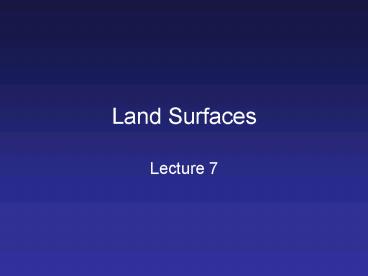Land Surfaces - PowerPoint PPT Presentation
1 / 13
Title:
Land Surfaces
Description:
... (deforestation) and stripping scrubs from arid regions (desertification) ... Sparse vegetation of arid and semi-arid areas can be easily removed or destroyed by ... – PowerPoint PPT presentation
Number of Views:21
Avg rating:3.0/5.0
Title: Land Surfaces
1
Land Surfaces
- Lecture 7
2
Land Surfaces
- Where people live, grow food, build home and
collect drinking water - Land surface vital for survival
- Exploitation of large areas of continents for
societal needs causes massive land disturbances - Exact nature of state of land and direction of
changes not easy to determine
3
Surface Energy Budget
- QS SWD SWULWD-LWU-LH-SE
- Where
- QS Net Energy Budget at the surface (W/m2)
- SWD Shortwave down at the surface (bottom)
- SWU Is the reflected SW at the surface, SWU
AsSWD - LWD Longwave down at the surface
- LWU Longwave up at the surface, LWU ess Ts4
- As Surface albedo
- Ts Surface temperature
- - es Surface emissivity
4
Surface Conditions
- 70 energy absorbed in climate system is at
Earths surface - Surface energy budget is sensitive to conditions
at the land surface, in particular the vegetation
cover - 50 of world continental surface has already been
altered by people - Forest replaced by fields
- Valleys flooded for reservoirs
- Roads and cities sprawling across coastal regions
- People activities cause or contribute to
desertification, deforestation, soil erosion
salinisation, reforestation, irrigation and
landscape development
5
Land surface changes
- Many relationship between land surface and global
environment are very complex - Potential contributions of land surface changes
to global environment - Greenhouse gas emissions
- Creation of aerosols (particulates and droplets)
- Surface reflectivity (albedo) and emissivity
disturbances - Impacts on surface roughness and hydrology
- Land clearance and land use now recognized as
having the potential to impact and be impacted by
local, regional and global climate
6
Land Changes impact on climate
- Replacing forests with grassland (deforestation)
and stripping scrubs from arid regions
(desertification) and urbanization have three
primary changes - Higher albedo and changes in emissivity
- Less evaporation
- Lower roughness
7
Desertification
- Affects millions of people
- Sparse vegetation of arid and semi-arid areas can
be easily removed or destroyed by overgrazing or
poor agricultural practices or as a result of
minor changes in climate - Removal of vegetation and exposure of bare soils
- decreased soil water storage capacity
- Increased runoff
- Increased albedo
- Less moisture availablegtdecreased latent heat
flux gt increased temperature - Higher temperaturegtincreased LW up and surface
radiative loss and large scale subsidencegt less
clouds and precipitation gt POSITIVE FEEDBACK
8
Deforestation
- Changes in surface hydrological characteristics
(less evapotranspiration) - Less moisture recycling gt less cloud and
precipitation - Not clear what the impact on temperature is
- Impacts can be felt at a distance from the
deforestation due to teleconnection
9
Biosphere
- Very important to climate
- Transfers moisture into atmosphere
- Modifies albedo which changes the amount of
radiation absorbed by climate system - Responsible for carbon and other chemical
exchanges - Modifies surface roughness which affects
exchanges of momentum (friction by wind)
10
Vegetation Reflectance
R SWBUP/SWBDOWN
11
Cryosphere
- Regions of the world covered by ice
- Greenland, Antarctic, large mountainous regions
(e.g., Himalaya) or high latitude regions
(Siberia) - Major changes over time (over long time scales)
- Amount of snow and ice controls variations in
global sea level - Regions where climate change is expected to be
first felt (temperature increase, snow/ice
melting) - Observable changes due to snow/ice albedo feedback
12
Snow/Albedo Feedback
- Greenhouse gases increase gt warming of surface
- When snow and ice are present on the warming
surface, it will melt - Melting induces reduction in surface albedo
(mostly by reduction of extend of snow/ice
regions) - As albedo decreases, more SW radiation is
absorbed - Surface warms up from SW absorption and its
temperature increases
13
Snow Reflectance
Reflectance
0.25
1.00
Wavelength (microns)































